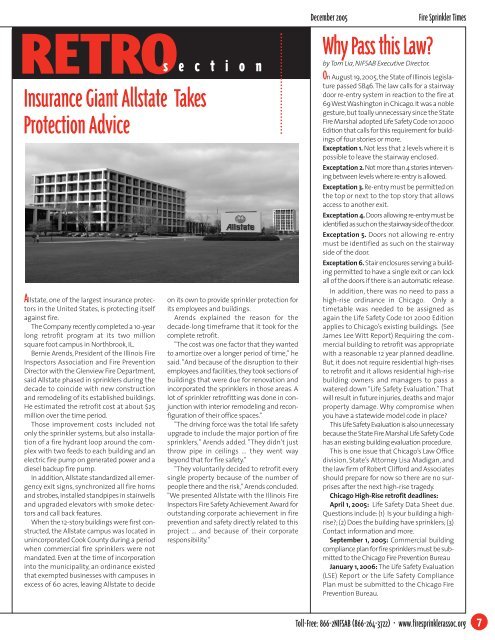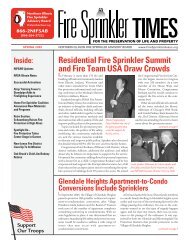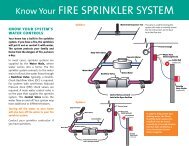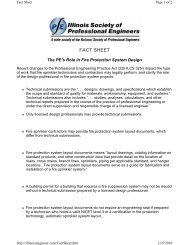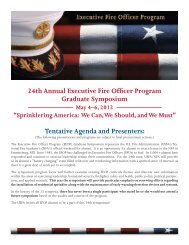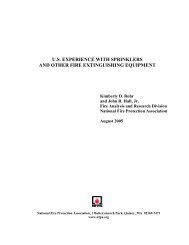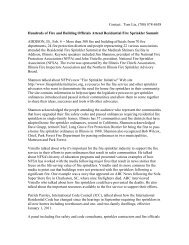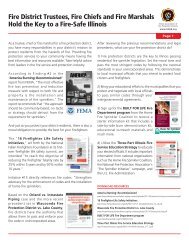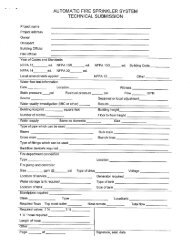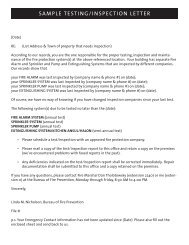#665 NLR-NIFSAB 2003-03_v3 - Northern Illinois Fire Sprinkler ...
#665 NLR-NIFSAB 2003-03_v3 - Northern Illinois Fire Sprinkler ...
#665 NLR-NIFSAB 2003-03_v3 - Northern Illinois Fire Sprinkler ...
Create successful ePaper yourself
Turn your PDF publications into a flip-book with our unique Google optimized e-Paper software.
RETROs e c t i o n<br />
Insurance Giant Allstate Takes<br />
Protection Advice<br />
Allstate, one of the largest insurance protectors<br />
in the United States, is protecting itself<br />
against fire.<br />
The Company recently completed a 10-year<br />
long retrofit program at its two million<br />
square foot campus in Northbrook, IL.<br />
Bernie Arends, President of the <strong>Illinois</strong> <strong>Fire</strong><br />
Inspectors Association and <strong>Fire</strong> Prevention<br />
Director with the Glenview <strong>Fire</strong> Department,<br />
said Allstate phased in sprinklers during the<br />
decade to coincide with new construction<br />
and remodeling of its established buildings.<br />
He estimated the retrofit cost at about $25<br />
million over the time period.<br />
Those improvement costs included not<br />
only the sprinkler systems, but also installation<br />
of a fire hydrant loop around the complex<br />
with two feeds to each building and an<br />
electric fire pump on generated power and a<br />
diesel backup fire pump.<br />
In addition, Allstate standardized all emergency<br />
exit signs, synchronized all fire horns<br />
and strobes, installed standpipes in stairwells<br />
and upgraded elevators with smoke detectors<br />
and call back features.<br />
When the 12-story buildings were first constructed,<br />
the Allstate campus was located in<br />
unincorporated Cook County during a period<br />
when commercial fire sprinklers were not<br />
mandated. Even at the time of incorporation<br />
into the municipality, an ordinance existed<br />
that exempted businesses with campuses in<br />
excess of 60 acres, leaving Allstate to decide<br />
on its own to provide sprinkler protection for<br />
its employees and buildings.<br />
Arends explained the reason for the<br />
decade-long timeframe that it took for the<br />
complete retrofit.<br />
"The cost was one factor that they wanted<br />
to amortize over a longer period of time," he<br />
said. "And because of the disruption to their<br />
employees and facilities, they took sections of<br />
buildings that were due for renovation and<br />
incorporated the sprinklers in those areas. A<br />
lot of sprinkler retrofitting was done in conjunction<br />
with interior remodeling and reconfiguration<br />
of their office spaces."<br />
"The driving force was the total life safety<br />
upgrade to include the major portion of fire<br />
sprinklers," Arends added. "They didn't just<br />
throw pipe in ceilings … they went way<br />
beyond that for fire safety."<br />
"They voluntarily decided to retrofit every<br />
single property because of the number of<br />
people there and the risk," Arends concluded.<br />
"We presented Allstate with the <strong>Illinois</strong> <strong>Fire</strong><br />
Inspectors <strong>Fire</strong> Safety Achievement Award for<br />
outstanding corporate achievement in fire<br />
prevention and safety directly related to this<br />
project … and because of their corporate<br />
responsibility."<br />
December 2005<br />
Why Pass this Law<br />
by Tom Lia, <strong>NIFSAB</strong> Executive Director.<br />
<strong>Fire</strong> <strong>Sprinkler</strong> Times<br />
On August 19,2005, the State of <strong>Illinois</strong> Legislature<br />
passed SB46. The law calls for a stairway<br />
door re-entry system in reaction to the fire at<br />
69 West Washington in Chicago.It was a noble<br />
gesture,but toally unnecessary since the State<br />
<strong>Fire</strong> Marshal adopted Life Safety Code 101 2000<br />
Edition that calls for this requirement for buildings<br />
of four stories or more.<br />
Exceptation 1. Not less that 2 levels where it is<br />
possible to leave the stairway enclosed.<br />
Exceptation 2. Not more than 4 stories intervening<br />
between levels where re-entry is allowed.<br />
Exceptation 3. Re-entry must be permitted on<br />
the top or next to the top story that allows<br />
access to another exit.<br />
Exceptation 4. Doors allowing re-entry must be<br />
identified as such on the stairway side of the door.<br />
Exceptation 5. Doors not allowing re-entry<br />
must be identified as such on the stairway<br />
side of the door.<br />
Exceptation 6. Stair enclosures serving a building<br />
permitted to have a single exit or can lock<br />
all of the doors if there is an automatic release.<br />
In addition, there was no need to pass a<br />
high-rise ordinance in Chicago. Only a<br />
timetable was needed to be assigned as<br />
again the Life Safety Code 101 2000 Edition<br />
applies to Chicago’s existing buildings. (See<br />
James Lee Witt Report) Requiring the commercial<br />
building to retrofit was appropriate<br />
with a reasonable 12 year planned deadline.<br />
But, it does not require residential high-rises<br />
to retrofit and it allows residential high-rise<br />
building owners and managers to pass a<br />
watered down “Life Safety Evaluation.”That<br />
will result in future injuries, deaths and major<br />
property damage. Why compromise when<br />
you have a statewide model code in place<br />
This Life Safety Evaluation is also unnecessary<br />
because the State <strong>Fire</strong> Marshal Life Safety Code<br />
has an existing building evaluation procedure.<br />
This is one issue that Chicago’s Law Office<br />
division, State’s Attorney Lisa Madigan, and<br />
the law firm of Robert Clifford and Associates<br />
should prepare for now so there are no surprises<br />
after the next high-rise tragedy.<br />
Chicago High-Rise retrofit deadlines:<br />
April 1, 2005: Life Safety Data Sheet due.<br />
Questions include: (1) Is your building a highrise;<br />
(2) Does the building have sprinklers; (3)<br />
Contact information and more.<br />
September 1, 2005: Commercial building<br />
compliance plan for fire sprinklers must be submitted<br />
to the Chicago <strong>Fire</strong> Prevention Bureau<br />
January 1, 2006: The Life Safety Evaluation<br />
(LSE) Report or the Life Safety Compliance<br />
Plan must be submitted to the Chicago <strong>Fire</strong><br />
Prevention Bureau.<br />
Toll-Free: 866-2<strong>NIFSAB</strong> (866-264-3722) • www.firesprinklerassoc.org 7


